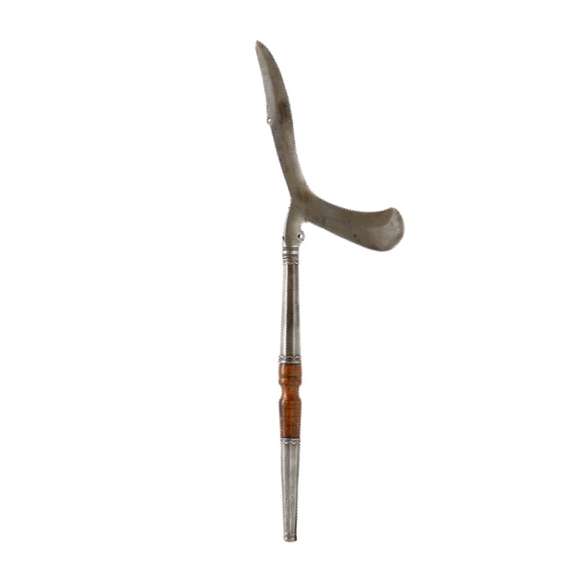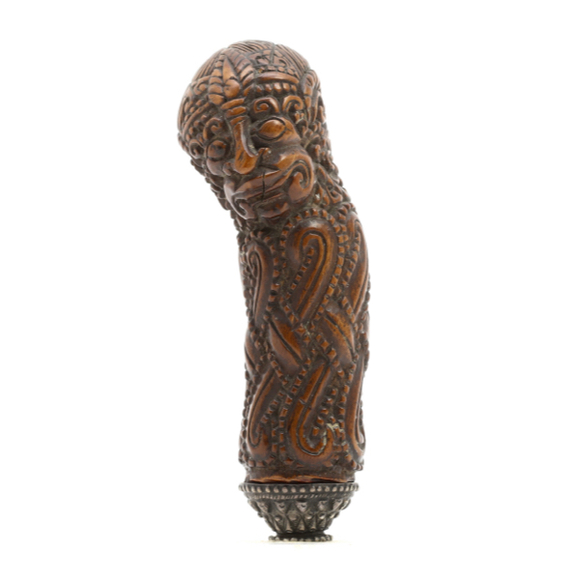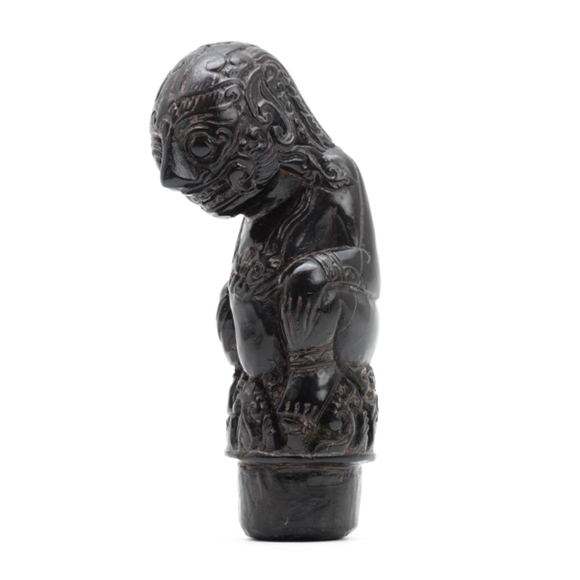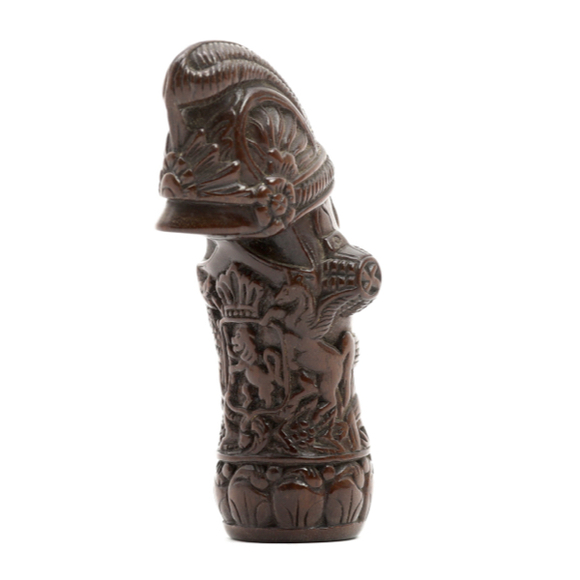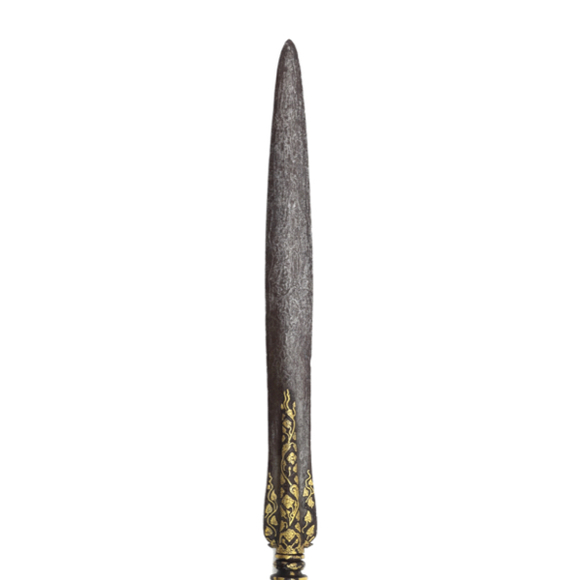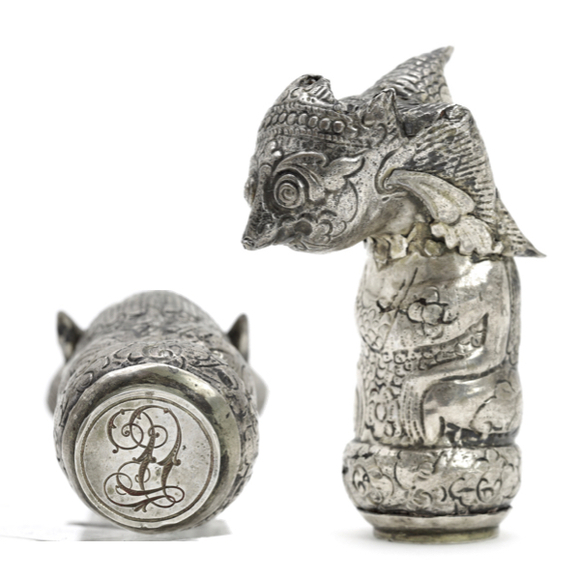Language: Indonesian
Source: Period writings
Description
Kudi are a peculiar form of weapon that derived off old Javanese farming tools. It comes in a very wide variety of shapes between which it is sometimes hard to see their relationship.1 A basic characteristic that is shared by all is that it has an ax-like section at the base of the blade that was meant for heavier chops, and a knife-like tip that was made for more delicate cuts.2
One of the earliest known artifacts of its type was found in a 14th-century site, illustrated below.

The 14th-century kudi illustrated by Snouck Hurgronje.
Stanford Raffles, writing in 1817 states:
"The kadi-tranchang is a weapon which was formerly general on Java, but not now much used." 3
Dutch sources also attribute the weapon mainly to Java and Madura. The Sundanese of West Java call it kujang (koedjang in Dutch sources). There is also mention of use in Madura where it was called kodhiq.4 It was said that it was initially a fighting weapon, but in the later period of its use often carried solely as a talisman and that waving it around would ward off ferocious animals like tigers.5
A simple variation called kudi bares, remained in use as a farming tool in the more remote areas of Java and Madura until at least the early 20th century.6
Some kudi in old Dutch publications
The kudi was the subject of some scholarly attention in the first years of the 20th century. In 1904, C. Snouck Hurgronje and G.A.J. Hazeu published each an article in Tijdschrift voor Indische Taal- Land- en Volkenkunde. Deel XLVII. Each published a set of drawings of kudi to illustrate their articles:

Left: Kudi as illustrated by C. Snouck Hurgronje in 1904.
Right: Kudi as illustrated by G.A.J. Hazeu in 1904.
Madurese kudi
The kudi remained in use the longest on the island of Madura, and even served as a local emblem of state until 1853.1

The Banner of Pamesakan, Madura, as it was until 1853.
The figure is identified as the Sang Jama, God of the underworld.
A kudi is seen in the hands of Sang Jama, and on the tip of the flagpole.
Illustration from Rouffaer, 1909.
Rouffaer, writing in 1909, illustrates a number of Madurese kudi that at that time were in the collection of a certain J.P. Moquette of Batavia. He owned about 30 examples that were originally collected in Pamekasan between 1889-1893 by a captain of infantry called P.A. Ouwens who transferred the collection to Moquette in 1906.2
Aware of the previous works, he chose to illustrate six notable kudi that he thought would complement the works of Snouck Hurgronje and Hazeu in 1904:

The Madurese kudi illustrated by Rouffaer in 1909.
1. A practical carpenter's kudi that could be used even to chop wood.
2. A very strong example of a Madurese carpenter's kudi.
3. An ornate variety that starts to look like a bird.
4. An unusual variety on which the head resembles more that of a horse.
5. The state kudi of the in 1853 deceased Pangeran of Pamekasan. The head shaped like a bird, the holes simulate its crest.
6. Scabbard of state kudi.
Notes to description
1. G.P. Rouffaer; De ouderwetsch-Javaansche koedi, nog algemeen op Madoera in zwang. Published in Tijdschrift voor Indische Taal-, Land- en Volkenkunde, Bataviaasch Genootschap van Kunsten en Wetenschappen. Deel LI. Batavia, Albrecht & Co. 1909.
2. C. Snouck Hurgronje; Iets over koedjang en badi. Published in Tijdschrift voor Indische Taal- Land- en Volkenkunde. Deel XLVII. Albrecht & Co, Batavia, 1904.
3. Sir Stanford Raffles; History of Java. Volume I. Murray, London. 1817. Page: 330.
4. G.P. Rouffaer; De ouderwetsch-Javaansche koedi. Published in Tijdschrift voor Indische Taal-, Land- en Volkenkunde, deel LI. 1909. Also see C. Snouck Hurgronje; Iets over koedjang en badi. Published in Tijdschrift voor Indische Taal- Land- en Volkenkunde. Deel XLVII. Albrecht & Co, Batavia, 1904.
5. Ibid.
6. Ibid.
7. G.P. Rouffaer; De ouderwetsch-Javaansche koedi, nog algemeen op Madoera in zwang. Published in Tijdschrift voor Indische Taal-, Land- en Volkenkunde, Bataviaasch Genootschap van Kunsten en Wetenschappen. Deel LI. Batavia, Albrecht & Co. 1909.
8. Ibid.
Names, subtypes and parts
Names
Javanese: Kudi, kudik (koedi in Dutch sources)
Sundanese: Kujang (koedjang in Dutch sources)
Madurese: Kodhiq
Subtypes in Javanese
Kudi bedes: a kudi with a monkey-shaped head
Kudi naga antaboga: a kudi with a serpent-shaped head
Kudi peksi: a kudi with a bird-shaped head
Kudi trantang: a long-handled variety with a turned wooden or horn handle called garan
Kudi wayang: a kudi with a wayang-shaped head
Parts in Javanese
Petel: heavy chopping part of blade.
Garan: turned horn or wooden handle of the kudi trantang.

